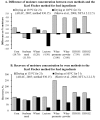Comparison of Oven-drying Methods for Determination of Moisture Content in Feed Ingredients
- PMID: 25358322
- PMCID: PMC4213707
- DOI: 10.5713/ajas.2014.14305
Comparison of Oven-drying Methods for Determination of Moisture Content in Feed Ingredients
Abstract
An accurate assessment of moisture content in feed ingredients is important because moisture influences the nutritional evaluation of feedstuffs. The objective of this study was to evaluate various methods for moisture content determination. In Exp. 1, the weight loss on drying (LOD) of corn, soybean meal (SBM), distillers dried grains with solubles (DDGS), whey permeate, whey powder, spray-dried porcine plasma (SDPP), fish meal, and a mixed diet of these 7 ingredients were measured by oven drying at 135°C for 2 h. Additionally, the samples were dried at 105°C for 3, 6, 9, 12, or 15 h. The LOD contents of the DDGS, whey permeate, and whey powder measured by drying at 135°C for 2 h were greater than the values measured by drying at 105°C for 3 h (p<0.05). All samples except SDPP (p = 0.70) dried at 105°C for 6, 9, 12, or 15 h caused more LOD compared with the samples dried for at 105°C for 3 h (p<0.05). The LOD contents of the individual ingredients were additive when dried at 105°C regardless of drying time. In Exp. 2, moisture contents of corn, SBM, wheat, whey permeate, whey powder, lactose, and 2 sources of DDGS (DDGS1 and DDGS2) were measured by the Karl Fischer method, oven drying at 135°C for 2 h, and oven drying at 125°C, 115°C, 105°C, or 95°C for increasing drying time from 1 to 24 h. Drying samples at 135°C for 2 h resulted in higher moisture content in whey permeate (7.5% vs 3.0%), whey powder (7.7% vs 3.8%), DDGS1 (11.4% vs 7.5%), and DDGS2 (13.1% vs 8.8%) compared with the Karl Fischer method (p<0.05). Whey permeate and whey powder were considerably darkened as the drying time increased. In conclusion, drying samples at 135°C for 2 h is not appropriate for determining the moisture content in whey permeate, whey powder, or DDGS as well as the mixed diet containing these ingredients. The oven-drying method at 105°C for 5 to 6 h appears to be appropriate for whey permeate and whey powder, and at 105°C for 2 to 3 h for DDGS.
Keywords: Dry Matter; Feed Ingredient; Karl Fischer Method; Loss on Drying; Moisture.
Figures


References
-
- AOAC. Official Methods of Analysis. 18th edn. Association of Official Analytical Chemists; Arlington, VA, USA: 2005.
-
- Ileleji KE, Garcia AA, Kingsly ARP, Clementson CL. Comparison of standard moisture loss-on-drying methods for the determination of moisture content of corn distillers dried grains with solubles. J AOAC Int. 2010;93:825–832. - PubMed
-
- Isengard H-D, Kling R, Reh CT. Proposal of a new reference method to determine the water content of dried dairy products. Food Chem. 2006;96:418–422.
-
- Kim BG, Kil DY, Zhang Y, Stein HH. Concentrations of analyzed or reactive lysine, but not crude protein, may predict the concentration of digestible lysine in distillers dried grains with solubles fed to pigs. J Anim Sci. 2012;90:3798–3808. - PubMed
-
- Mo M, Tjornhom T. Losses of carbon-containing substances during dry matter determination by oven drying. Acta Agric Scand. 1978;28:196–202.
LinkOut - more resources
Full Text Sources
Other Literature Sources

